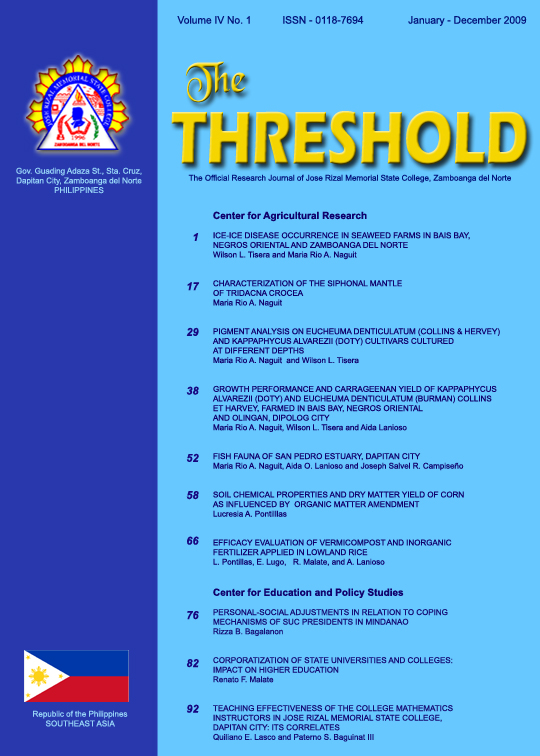CHARACTERIZATION OF THE SIPHONAL MANTLE OF TRIDACNA CROCEA
Keywords:
siphonal mantle, iridophores, hyaline organs, Tridacna crocea, T. maximaAbstract
Tridacna crocea is the smallest among the eight species of Family Tridacnidae and the most abundant tridacnids in reefs around the Philippine archipelago. This investigation describes the characteristic mantle pattern and color of T. crocea and correlates them to genetic structure; verifies the characteristic mantle color and pattern of T. crocea underwater and differentiates it from its closely related species, T. maxima in the field. Tissue samples of Tridacna crocea and T. maxima were collected and preserved in 95% alcohol. Prior to any mantle collection, each clam was photographed.Thirteen mantle patterns were identified from the 174 Tridacna crocea individuals of six reef areas: Pamilacan, Tanon Strait, Carbin, Camiguin, Southeastern Samar and Spratlys. Results revealed that Tridacna crocea can be distinguished from T. maxima in the field by the appearance and arrangement of their hyaline organs. Moreover, analysis on genotype-phenotype correlation using the T. crocea mantle morphology/color, found no significant relationship between the mantle morphs and genetic structure of the individuals.
References
Alcala, A.C.1986. Distribution and abundance of giant clams mollusks (Family Tridacnidae) in the south-central Philippines. Silliman Journal,
Alcazar, S. 1988. Spawning and larval rearing of tridacnid clams in the Philippines. In: J.Copland and J. Lucas, eds. Giant Clams in Asia and the Pacific. ACIAR Monograph No. 9, Canberra, Australia Pp. 125-128.
Benzie, J. A. H and S. T. Williams. 1998. Phylogenetic relationships among giant clam species (Mollusca: Tridacnidae) determined by protein electrophoresis. Marine Biology 132: 123-133.
Braley, R.1992. The giant clam: hatchery and nursery culture manual. ACIAR Monograph No. 15,Canberra. p.144
Calumpong, H.P., Ablan, M.C., Macaranas, J, Solis-Duran, E., Alcazar, S., Abdon- Naguit, R.1993. Biochemical evidence of self-fertil-ization in Hippopus species. In: Fitt WK (ed) Biology and mariculture of giant clams. Australian Centre for International Agricultural Research, Canberra, Australia, pp 103-110 (Proc.No. 47, ACIAR).
Calumpong, H.P. and P. Cadiz. 1993. Observations on the distribution of giant clams in protected areas. Silliman Journal 36 (2), 107-116.
Heslinga, G.A., T.C. Watson.1990. Giant clam farming . Pacific Fisheries Development Foundation (NMFS/NOAA), Honolulu, Hawaii, 179 p.
Juinio-Meñez, M.A., Magsino, R.M., Ravago-Gotanco, R., Yu, E.T., 2003. Genetic structure of Linckia laevigata and Tridacna crocea populations in the Palawan shelf and shoal reefs. Marine Biology 142, 717–726.
Laurent V, Planes S, Salvat B (2002) High variability of genetic pattern in giant clam (Tridacna maxima) populations within French Polynesia. Biological Journal of the Linnaean Society, 77, 221-231.
Lucas, J.S., Ledua, E., and Braley, R.D. 1991. Tridacna tevoroa Lucas,Ledua and Braley: a recently described species of giant clam (Bivalvia; Tridacnidae) from Fiji and Tonga. Nautilus 105:92-103
McMichael, D.F.1974. Growth rate, population size and mantle coloration in the small giant clam Tridacna maxima (Roding), at One TreeIsland, Capricorn Group, Queensland. Proceedings of the Second international Coral Reef Symposium 1: 241-254.
Rosewater, J. 1965. The family Tridacnidae in the Indo-Pacific. Mollusca 1: 347- 394
Schneider, J.A. and D.O.Foighil.1999. Phylogeny of giant clams (Cardiidae: Tridacninaebased on partial mitochondrial16s rDNA gene sequences. Molecular Phylogenetics and Evolution 13:59–66
Schneider J (1992) Preliminary cladisitic analysis of the bivalve family Cardiidae. American Malacological Bulletin 9: 145-155.
Stasek, C. R. 1966.The eye of the giant clam (Tridacna maxima).California Academy of Science.No. 58, pp. 9.
Zheng Zhang, Scott Schwartz, Lukas Wagner, and Webb Miller (2000), "A greedy algorithm for aligning DNA sequences", Journal of Computational Biology 2000; 7(1-2):203-14.
Downloads
Published
Issue
Section
License
Copyright (c) 2009 Maria Rio Naguit

This work is licensed under a Creative Commons Attribution-NonCommercial 4.0 International License.

